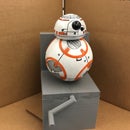Introduction: Easy In-Wall Theater Rack
Theater racks can be very noisy and distracting to your movie experience...here is how to fix that.
I wanted my Theater Room to be clean a quiet. This In-Wall Rack allows everything to be located anywhere you choose. I chose to put mine in a wall under the basement stairs with the back of the components in the Mechanical Room for easy access.
Please vote for me if you like this or are thinking about making one.
Step 1: Location...Location...Location
I only had a limited amount of space to put the rack in the wall. My issue was that in the mechanical room you can see there is the furnace to the right and a stud running in the center of where I want to put the rack.
My largest component in the rack is the receiver and it is 17" wide. Therefore I wanted the hole for the rack to have at least 1/2" on each side so I needed to make the hole 18" wide. The height is completely up to you. I wanted to add a couple of empty spots in mine so I could expand later on and not have to re-cut the hole.
Step 2: Framing It In
I had to cut the stud that was running right in the middle of the hole I cut out. I also had to add a new stud to the right side of the cutout. Once you do this you must frame the whole thing in. For my design you must have a stud all the way around the cutout and it should be flush with the hole. I will explain why later.
Step 3: Adding Shelves
My intention was to have enough room on both sides of the hole on the inside to just screw in a Dual Shelf Track
like the one pictured from the hardware store. I was able to screw one into the left side but the right side of the hole is flush with the furnace and I don't have enough room for the track. After a lot of thinking I picked up what are called an "over under shelf support". They have 90 degree bends at both ends but I had to flatten one of them out. I then screwed the flatten side into the inside framing of the hole. Then screwed the other end into the bottom side of the shelves. The left side of the shelves were supported with the simple Dual Track Shelf Supports and screwed to the bottom of the shelves.
You will have to mess around with the locations of your components and which notch you locate your shelf on. This would have been a lot simpler had I been able to use the tracks for both sides.
In the last photos here you can see that the shelves have a notch cut out on the left side so the track support can catch the shelf. The right side had to be cut straight because the Over Under shelf support wraps around the shelf
Step 4: Face Plates
For the face plates I went to a local machine shop and asked for some 1/16" aluminum pieces to be cut for me. You want to make them all individual pieces because if one of your components goes bad, you don't want to have to replace the whole aluminum sheet. You only have to replace the one section. You need to make the aluminum pieces at least 1" wider than the hole in the wall. This will give you 1/2" on each side to screw the aluminum plate into the studs.
I recommend placing the first aluminum piece at the top about 1/2" above the hole and centered up with 1/2" overhang on each side of the hole. Use tape and tape this piece really good to the wall. Then repeat with the other plates under this one. This pattern is the best way to prevent gaps between the pieces later.
Once you have all of you pieces taped to the wall add your shelves on the back side and add your first component. Push the component just up to the aluminum piece and trace the profile on the back side of the aluminum piece. Once you do that one move onto the next one until you have all of the profiles traced on the back of the aluminum pieces.
Step 5: Aluminum Cut-outs
This next step is the time consuming one. You need to cut out the profile of each of your components. You can use a Dremel, or drill a hole and use a hacksaw. You want to cut on the inside of your line and intentionally make the hold too small. Then you need to use a file to get the final profile you need for the sheet to slide right over the component. If you find the hole is located too high or too low, you can always make the component taller by stacking something under the feet, or if it is too tall you can take the feet off.
Once all of you components are cut out you can drill a small hole in all 4 corners of each of the aluminum plates. These will be screed into the studs and it will also make it look like a real server.
Step 6: Final Stages
I used a Matte Black spray paint with a slight texture to paint these plates. They turned out extremely well and I am glad I used the textured paint.
Only thing left now is to add trim around the aluminum plates.
I also added 2 angle brackets behind each component so I could not push them inward from the front.
Thank you for taking the time to read this Instructable!
Please vote for me!

Participated in the
Formlabs Contest

Participated in the
Fix & Repair Contest













